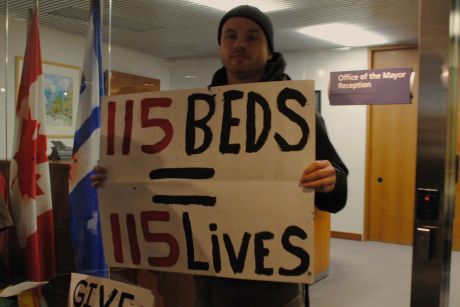Features
You are here
Homelessness in Toronto: a death sentence?

April 24, 2013
For decades, an army of social activists have proclaimed that there is an ongoing problem with poverty and homelessness in Toronto. These days the problem seems worse than ever.
Since 1985, there have been 700 homeless deaths on the streets of Toronto; forty-three of those deaths occurred in the last year alone, but that may be a very conservative estimate. According to Pastor Doug Johnson Hatlem, record-keeper of the Toronto Homeless Memorial Network, “there’s a lot that we don’t get on the list.” Many homeless individuals who die are not added to the list of deaths, because the identity of the deceased cannot be confirmed.
Cuts kill
According to Toronto Star reporter, Alyson Rowe, “Activists fear there will be even more homeless deaths in 2013 because of a 2.9 per cent cut to emergency shelter beds in the city budget.” These cuts will result in the loss of 100 shelter beds, along with related food and support services. Approved by Mayor Rob Ford, these losses will ensure that ever-increasing numbers of homeless individuals will be dying on the streets of Toronto in the winter of 2013-2014.
Cuts affecting the lives of the homeless in Toronto began long before Rob Ford became Mayor. More than 300 shelter beds were lost in 2006 (when David Miller was in power), with severe cuts to spending on shelters, affordable housing, and programs such as addictions and mental health support services.
Magical beds
Ford’s opinion on shelter spaces is clear: “we don’t need more spaces. We have over a hundred empty beds a night. We have to be efficient.” But if there are more than enough shelter spaces, as Ford claims, then why are Toronto activists and shelter workers claiming to have a critical shortage of shelter beds?
The “beds” that Ford was referring to are nothing more than “Magical Beds,” says Hatlem. They are nothing more than imaginary spaces that “no one ever gets to sleep in”; spaces where a cot can fit in an emergency if squeezed between existing double decked beds. These emergency cot spaces, sometimes referred to as overflow beds, were never intended to be counted as “shelter beds” and do not exist.
Emergency shelter
In an attempt to prevent more needless deaths of homeless Torontonians, the Ontario Coalition Against Poverty (OCAP) began to forcefully occupy sections of Metro City Hall, making it a temporary out of the cold shelter, and taking social justice for the homeless to the streets.
All of the discussion in the media about OCAP and Rob Ford arguing over shelter spaces missed a key fact: that Metro Hall is supposed to be opened as a homeless shelter in the event that shelters are overcrowded, which they have been since at least 2012. In 1999 the City of Toronto made a policy that would allow Metro Hall as to be used as emergency shelter space. This policy states that the city's shelters not be allowed to exceed a 90 per cent occupancy rate, and if it did, Metro Hall should be opened up as an emergency shelter.
Shelters in Toronto operate at 96 per cent capacity, and the overcrowding within shelters has led to extremely unsafe conditions that force many people to avoid them--preferring to risk death on the cold streets rather than to brave the violent, unsanitary conditions of some Toronto shelters. Many people who use shelters risk physical abuse, assault as well as exposure to HIV, hepatitis, and bed bugs.
Many shelters do provide a safe environment for homeless individuals, but others do not. Seaton House, a downtown Toronto homeless shelter, is a dangerous place to be. This shelter is often referred to by the homeless community as “Satan House,” due to its highly unsafe and dangerous conditions.
Housing is not a priviledge, it's a right
Seasoned activist Don Weitz notes that even the existence of shelter spaces for every homeless person in Toronto (and Canada) wouldn’t solve the underlying social problems exposed in bed shortages. Weitz, a 36 year social justice veteran and activist, states that “Housing is not a privilege, it’s a right.”
According to Toronto’s 10 year plan housing initiative, “The best way to end homelessness is to provide permanent housing.” With Ford’s cut to the shelter support system, this goal seems further away than ever.
Weitz identifies that homelessness is a creation of neoliberal politics and policies at all levels of government. Weitz also says, “Poverty can be corrected, and even solved under a socialist government where the people are treated justly, as humans who deserve their dignity and human rights.”
Ford and Steven Harper have declared war against the poor. When a government puts tax cuts for the rich ahead of the needs of its most vulnerable citizens, people must fight back.
If you like this article, register now for Marxism 2013: Revolution In Our Time, a weekend-long conference of ideas to change the world. Sessions include "Solidarity against austerity: lessons from the front-lines", "Why is capitalism in crisis", and "Disability, austerity and resistance"
Section:
Topics:










